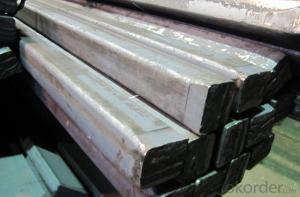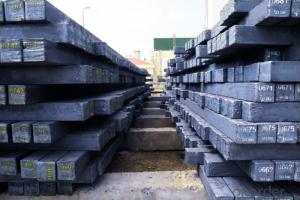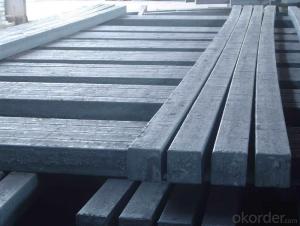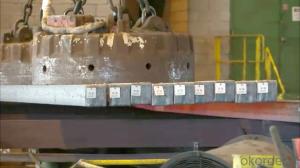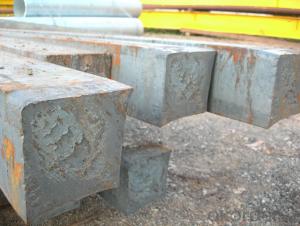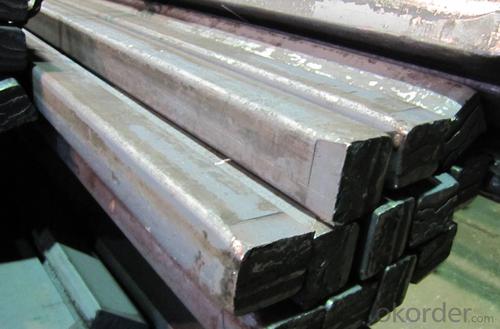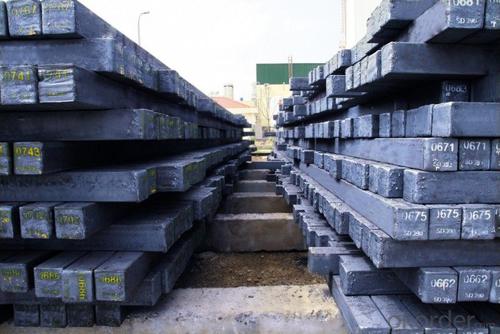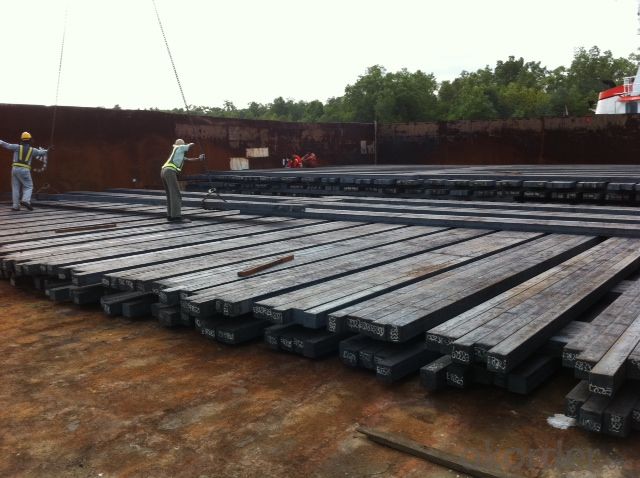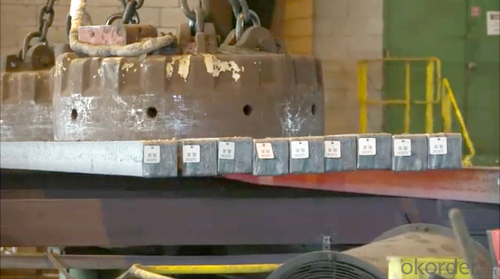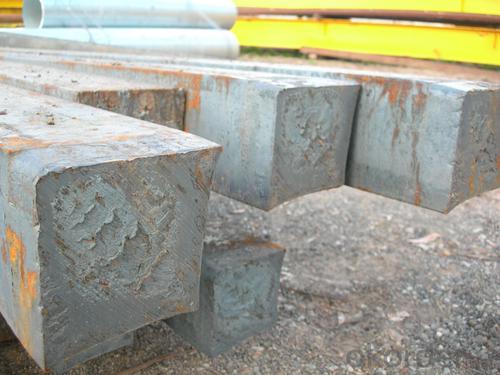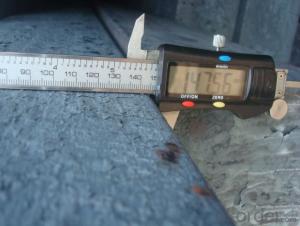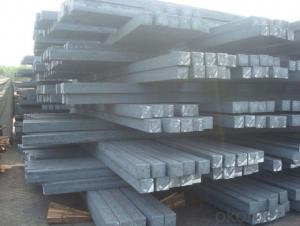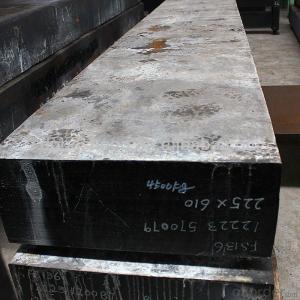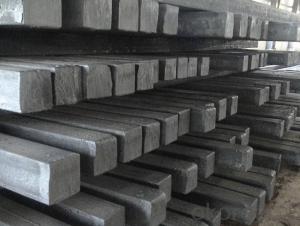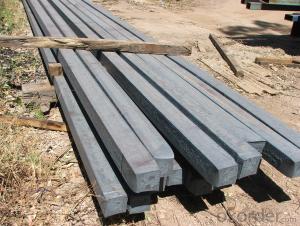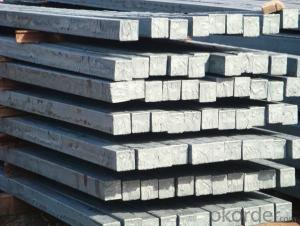Prime Q275 160mm Square Alloy Steel Billet
- Loading Port:
- Shanghai
- Payment Terms:
- TT OR LC
- Min Order Qty:
- 100 m.t.
- Supply Capability:
- 10000 m.t./month
OKorder Service Pledge
OKorder Financial Service
You Might Also Like
Structure of Prime Q275 160mm Square Alloy Steel Billet
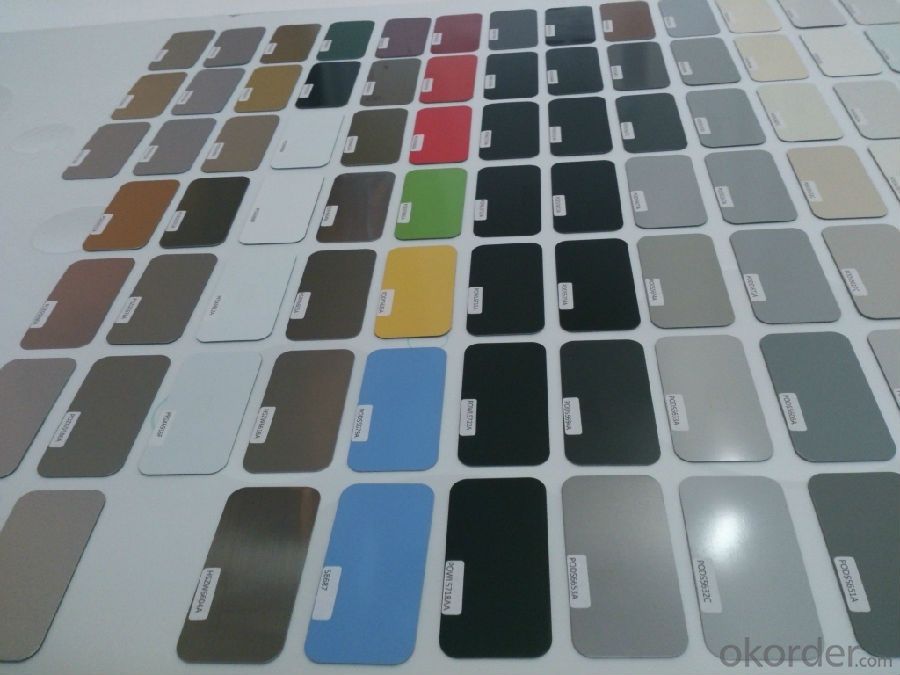
Description of Prime Q275 160mm Square Alloy Steel Billet
1. Prepainted steel coil is coated with organic layer, which provides higher anti-corrosion property and a longer lifespan than that of galvanized or galvalume steel sheets.
2. The base metals for prepainted steel coil consist of cold rolled, HDGI Steel, electro-galvanized and hot-dip alu-zinc coated steel. The finish coats of prepainted steel coil can be classified into groups as follows: polyester, silicon modified polyesters, polyvinylidene fluoride, high-durability polyester, etc.
3. The production process has evolved from one-coating-and-one-baking to double-coating-and-double-baking, and even three-coating-and-three-baking.
4. The color of the prepainted steel coil has a very wide selection, like orange, cream-colored, dark sky blue, sea blue, bright red, brick red, ivory white, porcelain blue, etc.
5. The prepainted steel coils can also be classified into groups by their surface textures, namely regular prepainted sheets, embossed sheets and printed sheets.

Main Feature of Prime Q275 160mm Square Alloy Steel Billet
They were one of several reasons for the wind to be taken out of the sails of the recent oil price momentum. Kuwait’s oil minister said that his country would only commit to a production freeze if all major producers are involved, including Iran. We also had Goldman telling us that oil markets will not rebalance at $40/bbl as it throws a lifeline to cash-strapped US producers.
If it is talk of a production freeze that is behind the rally it shows how low expectations have fallen. It is in the nature of oil people to talk the market up. Any bullish crumb is given exaggerated significance and any port in a storm will do. It is all but fact that the oil market will be tighter in the second half of this year when seasonal demand shoots up and US production continues to decline. It was the same picture last year. If OPEC and key non-OPEC production is frozen that will ensure the daily surplus will fall, but in all likelihood there will still be a surplus and there is an enormous global stockbuild to burn off.
Applications of Prime Q275 160mm Square Alloy Steel Billet
A. Corrugated design makes it excellent waterproof performance
B. Materials as prepainted steel sheets, galvanized steel sheets, galvalume (Al-Zn coated sheets) are available to make corrugated sheet.
C.Those material are durable, anti-corrosion in bad weather for 20-30 years based on it's Zinc(Galvanized) coating or AZ (Galvalume) coating.
D. Different shape of the sheet make it suitable for any style of buildings.
E.Easy to install, no need special tools to fix the sheet.
F.Light weight due to high strength to weight ratio of steel. Light weight means easier handling lower shipping costs, easier installation
G. Different color is availbe base on the RAL Standard make your building more beautiful.
H. We will provide the best solutions if you don't have a exact idea of the specification you want for the steel sheet based on your weather conditions, engineering structure, construction budget and so on.
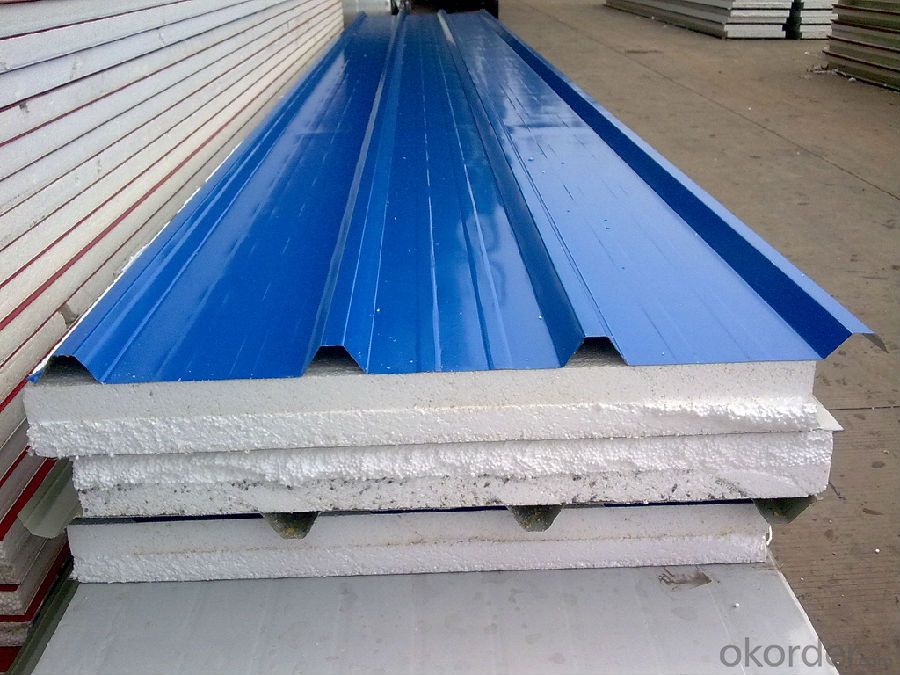
Specifications of Prime Q275 160mm Square Alloy Steel Billet
Product | Billet |
Material Grade | SGCC / SGCH / DX51D+AZ, etc |
Thickness | 0.6-3.0mm |
Width | 500-1500mm |
Tolerance | Thickness: +/-0.02mm , Width:+/-2mm |
Zinc-coating | Z30-150g/m2 |
Technique | Raw material: Hot rolled steel coil --> Cold rolled_>hot dipped galvalume |
Surface | Dried, Chromated, Unoiled |
Spangle | Regular spangle , small spangle, zero spangle |
ID | 508MM 610MM |
Coil weight | 1-25MT |
Export package | Cardboard inner sleeves, Waterproof paper, galvanized steel covered and steel strip packed |
FAQ of Prime Q275 160mm Square Alloy Steel Billet
We have organized several common questions for our clients,may help you sincerely:
1. How Can I Visit There?
Our company is located in Tianjin City, China, near Beijing. You can fly to Tianjin Airport Directly. All our clients, from home or aboard, are warmly welcome to visit us!
2. How Can I Get Some Sample?
Poor trade figures from China punctured commodity optimism yesterday although they came with warnings that perhaps the numbers were distorted by Chinese New Year celebrations and we will have to wait for the March figures to gain a true picture of the state of China’s landing. Exports for February were -25.4% and imports -13.8% year-on-year.
- Q: How are steel billets recycled or reused?
- Various methods can be employed to recycle or reuse steel billets, which are semi-finished metal products. One commonly used method is electric arc furnace (EAF) steelmaking, where the billets are melted down in an electric arc furnace and utilized in the production of new steel products. This process effectively utilizes resources and aids in the reduction of greenhouse gas emissions and energy consumption compared to primary steel production. Steel billets can also be repurposed in industries like construction, automotive, and manufacturing. They can be transformed and reconfigured to create novel steel products or utilized as raw material for forging, rolling, or extrusion processes. By reusing steel billets, the industry can alleviate the demand for newly manufactured steel and conserve natural resources. Moreover, steel billets can be recycled through continuous casting. In this technique, the molten steel is poured into a continuous casting machine, resulting in the formation of solid billets. These billets can then undergo hot or cold rolling processes to produce various steel products such as bars, rods, or wire. Furthermore, steel billets can be melted and recast into different forms via remelting. Technologies like induction melting or vacuum arc remelting can be employed to purify the steel and achieve desired chemical and mechanical properties. Remelting facilitates the production of high-quality steel billets suitable for specialized applications in industries such as aerospace, defense, or medical sectors. In conclusion, steel billets are effectively recycled or reused through processes like electric arc furnace steelmaking, continuous casting, remelting, and reshaping. These methods not only contribute to the sustainability of the steel industry but also aid in resource conservation, emission reduction, and meeting the rising demand for steel products.
- Q: What are the different types of forging processes used for shaping steel billets?
- Steel billets can be shaped using various forging processes. Among these are open die forging, closed die forging, and ring rolling. Open die forging involves compressing the steel billet between two flat dies to give it shape. This method is suitable for larger and simpler shapes as the steel is not fully enclosed by the dies, allowing for flexibility in the final product's shape. Closed die forging, also known as impression die forging, utilizes specially designed dies with cavities in the desired shape of the final product. The steel billet is placed between these dies and compressed, causing the metal to flow and take on the shape of the cavities. This process is ideal for more intricate shapes and provides greater precision and control over the final result. For shaping steel billets into rings, ring rolling is employed. This process involves placing the billet on a mandrel and applying pressure with a series of rollers, causing the billet to deform and acquire the shape of a ring. Ring rolling is commonly used in the production of seamless rolled rings, which find extensive application in industries like aerospace, oil and gas, and power generation. In conclusion, the selection of the appropriate forging process depends on factors such as the complexity of the desired shape, the level of precision required, and the specific needs of the end application.
- Q: What are the potential applications of steel billets in the chemical aftermarket?
- Steel billets have several potential applications in the chemical aftermarket. They can be used as raw material for the production of various chemical products, such as pipes, tanks, and containers. Additionally, steel billets can be utilized in the construction of chemical processing equipment, such as reactors and heat exchangers, due to their strength and durability. Furthermore, they can also serve as a base material for the fabrication of specialty alloys used in the chemical industry. Overall, steel billets play a crucial role in supporting the production and infrastructure needs of the chemical aftermarket.
- Q: How are steel billets used in the manufacturing of oil and gas components?
- Steel billets are used in the manufacturing of oil and gas components as they serve as the raw material for various parts such as pipes, valves, flanges, and fittings. These billets are heated and then shaped through processes like extrusion, forging, or rolling to create the desired component. The strength, durability, and resistance to corrosion of steel make it an ideal material for oil and gas applications, ensuring the reliability and safety of the components used in the industry.
- Q: What is the lifespan of a steel billet?
- The lifespan of a steel billet can vary depending on several factors such as the quality of the steel, the conditions in which it is stored and used, and the specific application it is being used for. Generally, steel billets are designed to have a long lifespan and can be used for many years without significant degradation. Steel billets are typically made from high-quality steel that is specifically engineered to have excellent strength, durability, and resistance to corrosion. This ensures that the billet can withstand the rigors of various industrial processes and applications. In terms of storage and usage conditions, steel billets need to be stored in a dry and controlled environment to prevent moisture and other contaminants from causing rust or degradation. They should also be handled and transported carefully to prevent any physical damage that could compromise their integrity. The lifespan of a steel billet also depends on the specific application it is being used for. Some billets are used in high-stress applications such as construction, automotive manufacturing, or heavy machinery, where they may undergo significant wear and tear. In these cases, the lifespan of the billet can be shorter compared to less demanding applications. Overall, with proper care, maintenance, and adherence to recommended usage guidelines, a steel billet can have a long lifespan ranging from several years to decades. Regular inspections, maintenance, and replacement of worn or damaged billets are essential to ensure optimal performance and safety in various industries.
- Q: Can steel billets be used in the production of aerospace components?
- Yes, steel billets can be used in the production of aerospace components. Steel billets are semi-finished steel products that can be further processed into various shapes and sizes. They are commonly used in industries such as aerospace, automotive, and construction. In the aerospace industry, steel billets can be used to create components such as shafts, gears, and structural parts. However, it is important to note that the specific type of steel used in aerospace applications must meet stringent requirements for strength, durability, and resistance to high temperatures and corrosion. Therefore, steel billets used in aerospace production need to undergo additional processes such as heat treatment, machining, and surface finishing to achieve the required properties and dimensions. Overall, while steel billets can be used in aerospace component production, it is crucial to ensure that the steel material and manufacturing processes meet the necessary specifications and standards for safety and performance in the aerospace industry.
- Q: How are steel billets used in the manufacturing of rail tracks?
- The manufacturing of rail tracks relies heavily on steel billets, which serve as a vital component. These billets, semi-finished steel pieces, are widely used as the initial material in various metalworking procedures. In the case of rail track production, the steel billets are subjected to high temperatures and subsequently passed through a sequence of rolling mills. During the rolling procedure, the steel billets gradually take shape and elongate, forming rail blooms that are characterized by their long and narrow sections. These rail blooms then undergo further processing and shaping through hot rolling, which involves passing them through multiple sets of rollers to achieve the desired dimensions and shape of the rail track. This process contributes to enhancing the mechanical properties of the steel, such as its strength and durability. Once the rail blooms have been shaped, they go through controlled cooling, a process in which they are cooled at a specific rate to optimize their microstructure and properties. This controlled cooling aids in reducing internal stresses and improving the overall quality of the rail tracks. Following the controlled cooling process, the rail blooms are subjected to straightening, cutting, and ultimately, finishing operations. These operations ensure that the rail tracks are straight, possess precise dimensions, and conform to the required standards and specifications. In conclusion, steel billets play a critical role in the manufacture of rail tracks. They are transformed into rail blooms through a series of rolling processes, and subsequently undergo further processing to produce high-quality rail tracks that are strong, durable, and capable of withstanding the heavy loads and constant use associated with railway transportation systems.
- Q: Does anyone know how much it costs to refine a ton of steel? What are the expenses involved?
- Electricity, water, wages, raw materials, raw materials loss, charges, oxygen, according to their own circumstances, as well as freight and other expenses, now the steel profits are not as good as before, a ton of net profit is about 100 yuan
- Q: What is the typical length of a steel billet?
- The typical length of a steel billet can vary depending on the specific industry and application, but it is commonly between 3 to 12 meters.
- Q: What are the different types of steel billet defect detection methods?
- There are several different types of steel billet defect detection methods that are commonly used in the industry. These methods help identify any defects or imperfections present in the steel billets, ensuring that only high-quality products are being produced. Some of the different types of steel billet defect detection methods include: 1. Visual Inspection: This is the most basic and common method, where trained inspectors visually examine the billets for any visible defects such as cracks, surface irregularities, or deformations. While effective for detecting certain types of defects, this method may not be able to identify internal or hidden defects. 2. Ultrasonic Testing: This method uses high-frequency sound waves to detect defects within the billets. Ultrasonic waves are passed through the billet, and any irregularities or disruptions in the waves indicate the presence of defects such as cracks or voids. Ultrasonic testing is a widely used technique for detecting internal defects. 3. Magnetic Particle Inspection: This method involves magnetizing the steel billet and then applying iron particles. If there are any surface or near-surface defects, the particles will be attracted to these areas, making the defects visible. Magnetic particle inspection is particularly effective for detecting surface cracks and discontinuities. 4. Eddy Current Testing: This technique uses electromagnetic induction to detect surface or near-surface defects in steel billets. A coil carrying an alternating current is placed near the billet, and any changes in the electrical conductivity or magnetic properties of the material caused by defects are detected. Eddy current testing is particularly useful for detecting surface cracks and corrosion. 5. X-ray Testing: X-ray inspection involves passing X-ray radiation through the steel billet and capturing the resulting image on a film or digital detector. Any internal defects such as cracks, voids, or inclusions will show up as dark spots on the X-ray image. X-ray testing is highly effective for detecting internal defects. 6. Laser Scanning: This method uses a laser scanner to create a three-dimensional image of the steel billet's surface. Any irregularities or deformations in the surface can be detected and analyzed using specialized software. Laser scanning is a precise and efficient method for detecting surface defects. These are just a few of the different types of steel billet defect detection methods that are commonly used in the industry. Each method has its own advantages and limitations, and the choice of method depends on factors such as the type of defect being targeted, the size and shape of the billets, and the level of precision required. By employing these defect detection methods, manufacturers can ensure the production of high-quality steel products.
Send your message to us
Prime Q275 160mm Square Alloy Steel Billet
- Loading Port:
- Shanghai
- Payment Terms:
- TT OR LC
- Min Order Qty:
- 100 m.t.
- Supply Capability:
- 10000 m.t./month
OKorder Service Pledge
OKorder Financial Service
Similar products
Hot products
Hot Searches
Related keywords
